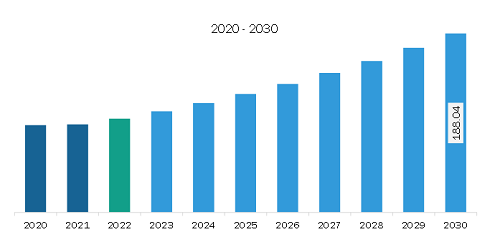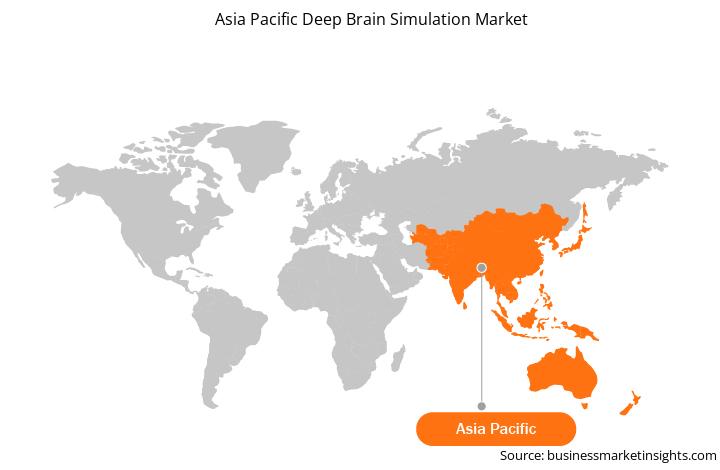Robotic implantation, multi-target stimulation, improved microelectrode designs, rechargeable pulse generators, and personalized, targeted programming are among the technological advancements in deep brain stimulation (DBS). Owing to these advancements, DBS devices show fewer side effects and improved efficacy and symptom relief in Parkinson's patients compared to traditional methods. Abbott's Infinity Deep Brain Stimulation System is a technologically advanced new DBS that helps the patients manage their symptoms. It is the first wireless iOS software DBS mobile platform that has offered efficient and personalized therapy management with reduced risk of side effects. According to the MGM Healthcare press release published in February 2020, MGM Healthcare, Tamil Nadu, performed its first deep brain stimulation (DBS) for obsessive-compulsive disorder (OCD). Therefore, technological advancements in DBS are expected to create opportunities for the Asia Pacific deep brain stimulation market during the forecast period.
China is home to the world's largest population of older adults. According to a study published in The Lancet titled “China's Aging Population: Crisis or Opportunity?” in 2019, people in China aged 60 or older were ~254 million. By 2040, that number is expected to rise to 402 million, ~28% of the population. These changes have profound public health implications in the country as the risk and burden of noncommunicable diseases increase along with the demand for health and social care systems. Parkinson's disease (PD) is a common neurodegenerative disease in the country. According to ChinaDaily, there were approximately 4 million Parkinson's patients in China as of February 2023, and ~1.7% of people over 65 years have been diagnosed with the disease. According to a study discussed in the Journal of Health, Population, and Nutrition, the number of people with Alzheimer's disease in China is ~6 million, with dementia rates among 65-, 75-, and 85-year-olds being 5%, 11.5%, and 30%, respectively. Deep brain stimulation (DBS) of the subthalamic nucleus (STN) is effective in the treatment of Parkinson's disease (PD). With advancements in DBS hardware, researchers have developed several novel programming technologies, of which remote programming is widely used in China. Since 2018, we have been performing remote programming for patients suffering from PD using PINS products (PINS Medical, Ltd., Beijing, China). For patients with advanced Parkinson's disease (over a 15-year time horizon), DBS is considered to be a highly effective treatment option. However, DBS remains a significant economic burden on the patient when not reimbursed, unlike in any other developed country. In China, the surgery cost is mainly covered by the patient's health insurance, but the cost of DBS hardware is only partially covered, which can hamper the growth of the market in the country.
Strategic insights for the Asia Pacific Deep Brain Simulation provides data-driven analysis of the industry landscape, including current trends, key players, and regional nuances. These insights offer actionable recommendations, enabling readers to differentiate themselves from competitors by identifying untapped segments or developing unique value propositions. Leveraging data analytics, these insights help industry players anticipate the market shifts, whether investors, manufacturers, or other stakeholders. A future-oriented perspective is essential, helping stakeholders anticipate market shifts and position themselves for long-term success in this dynamic region. Ultimately, effective strategic insights empower readers to make informed decisions that drive profitability and achieve their business objectives within the market. The geographic scope of the Asia Pacific Deep Brain Simulation refers to the specific areas in which a business operates and competes. Understanding local distinctions, such as diverse consumer preferences (e.g., demand for specific plug types or battery backup durations), varying economic conditions, and regulatory environments, is crucial for tailoring strategies to specific markets. Businesses can expand their reach by identifying underserved areas or adapting their offerings to meet local demands. A clear market focus allows for more effective resource allocation, targeted marketing campaigns, and better positioning against local competitors, ultimately driving growth in those targeted areas.
Asia Pacific Deep Brain Simulation Strategic Insights

Asia Pacific Deep Brain Simulation Report Scope
Report Attribute
Details
Market size in 2022
US$ 98.35 Million
Market Size by 2030
US$ 188.04 Million
Global CAGR (2022 - 2030)
8.4%
Historical Data
2020-2021
Forecast period
2023-2030
Segments Covered
By Product
By Application
By End User
Regions and Countries Covered
Asia-Pacific
Market leaders and key company profiles
Asia Pacific Deep Brain Simulation Regional Insights

Asia Pacific Deep Brain Simulation Market Segmentation
The Asia Pacific deep brain simulation market is segmented into product, application, end user, and country.
Based on product, the Asia Pacific deep brain simulation market is segmented into single channel deep brain stimulator, dual channel deep brain stimulator, and software and accessories. In 2022, the dual channel deep brain stimulator segment registered the largest share in the Asia Pacific deep brain simulation market.
Based on application, the Asia Pacific deep brain simulation market is segmented into Parkinson’s disease, tremor, dystonia, epilepsy, Alzheimer’s disease, and others. In 2022, the Parkinson’s disease segment registered the largest share in the Asia Pacific deep brain simulation market.
Based on end user, the Asia Pacific deep brain simulation market is segmented into hospitals, neurology clinics, ambulatory surgical centers, and others. In 2022, the hospitals segment registered the largest share in the Asia Pacific deep brain simulation market.
Based on country, the Asia Pacific deep brain simulation market is segmented into China, Japan, India, South Korea, Australia, and the Rest of Asia Pacific. In 2022, China segment registered the largest share in the Asia Pacific deep brain simulation market.
Abbott Laboratories, Beijing PINS Medical Co Ltd, Boston Scientific Corp, Medtronic Plc, and SceneRay Co Ltd are some of the leading companies operating in the Asia Pacific deep brain simulation market.
The Asia Pacific Deep Brain Simulation Market is valued at US$ 98.35 Million in 2022, it is projected to reach US$ 188.04 Million by 2030.
As per our report Asia Pacific Deep Brain Simulation Market, the market size is valued at US$ 98.35 Million in 2022, projecting it to reach US$ 188.04 Million by 2030. This translates to a CAGR of approximately 8.4% during the forecast period.
The Asia Pacific Deep Brain Simulation Market report typically cover these key segments-
The historic period, base year, and forecast period can vary slightly depending on the specific market research report. However, for the Asia Pacific Deep Brain Simulation Market report:
The Asia Pacific Deep Brain Simulation Market is populated by several key players, each contributing to its growth and innovation. Some of the major players include:
The Asia Pacific Deep Brain Simulation Market report is valuable for diverse stakeholders, including:
Essentially, anyone involved in or considering involvement in the Asia Pacific Deep Brain Simulation Market value chain can benefit from the information contained in a comprehensive market report.